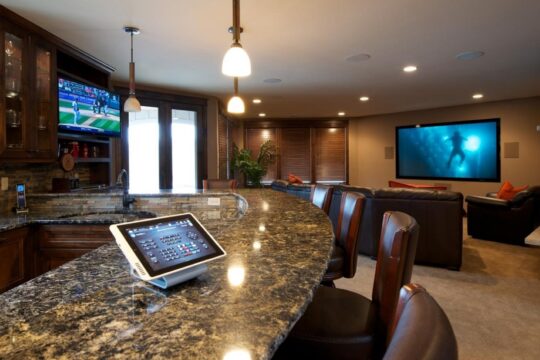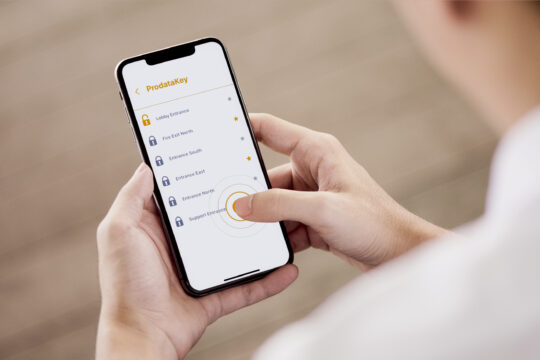Home automation installations Los Angeles have become increasingly popular as technology has advanced. Home automation installations allow you to access and control all of your home’s devices remotely from a single device. This means that you can control lighting, heating, security systems, audio-visual systems, and other appliances from anywhere in the world with an internet connection. Home automation installation services in Los Angeles can help you make your home smarter, more efficient, and keep it safe. From basic setup to full home integration, there are many options available for homeowners looking to upgrade their home’s systems.
Definition of home automation
Home automation is the use of technology to automate various functions in a home in Los Angeles. This includes controlling lights, heating and cooling systems, security systems, appliances, entertainment systems, and more. Home automation enables homeowners to remotely control all of these elements from a single device or app.
 Importance of home automation
Importance of home automation
1. Convenience: Home automation ensures that all the devices in the home are interconnected such that they can be operated remotely or through voice commands. This means that homeowners can control their lights, heating, appliances, and security systems from anywhere in the world.
2. Comfort: Automated homes provide maximum comfort to the occupants. For instance, the lighting system can be automated to simulate natural sunlight, which can help reduce stress levels.
3. Energy efficiency: Home automation technology reduces the amount of energy consumed in the home by allowing homeowners to regulate their utility usage. Smart thermostats, for example, can learn and adjust temperature preferences based on the occupants’ schedules, effectively reducing energy consumption.
4. Increased home security: Home automation technology provides advanced security measures, such as motion detectors, door sensors, and video surveillance, helping to deter criminals and monitor the home.
5. Better accessibility: Home automation simplifies everyday tasks for people with disabilities. For instance, voice-activated systems and smartphones can be used to lock and unlock doors, making it easier for people with mobility issues.
Different Types Of Home Automation Systems
1. Wired home automation systems: These are systems that require the installation of wires throughout the home to connect the devices and appliances to the central control unit.
2. Wireless home automation systems: These systems use wireless technologies such as Wi-Fi, Bluetooth, or Zigbee to connect the devices and appliances to the central control unit. They are easier to install and are flexible in terms of adding or removing devices.
3. Powerline home automation systems: These systems use the existing power lines to transmit control signals throughout the home.
4. Smart home automation systems: These are advanced systems that work with artificial intelligence and machine learning algorithms to learn and adapt to the homeowner’s preferences and behaviors.
5. Voice-controlled home automation systems: These systems use voice recognition technology to enable homeowners to control their devices and appliances through voice commands.
6. Standalone home automation systems: These systems are designed for specific devices or appliances and do not require a central control unit. Examples include smart thermostats, smart locks, and smart lighting.
7. Hybrid home automation systems: These systems combine wired and wireless technologies to offer a more flexible and customizable solution.
Planning For The Installation Process
Here are some general guidelines that you can follow when planning for the installation process:
1. Identify the areas in your home that you want to automate. This includes identifying the appliances, lighting fixtures, thermostats, and security systems that will be integrated into the automation system.
2. Determine the functionality you want from your system. For example, you may want to set schedules for your lighting and temperature control or have the ability to monitor and control your home security from your smartphone.
3. Determine the level of automation you want. You may want a full home automation system that controls everything from the lighting to the entertainment system, or you may want a more basic system that only controls certain aspects of your home.
4. Choose the right devices. Once you have determined the areas to automate, the functionality you want, and the level of automation you want, it’s time to choose the right devices. Determine the compatibility of the devices with the automation system you have chosen.
5. Create a diagram or map of the system. It is always helpful to create a diagram or map of the system before installation to ensure that everything is in the right place and to ensure that the automation system provides full coverage of your home.
6. Hire a professional. For complicated installations, it may be best to seek the assistance of a professional automation installer.
7. Test the system. Once the installation is complete, test the entire system to ensure that everything is working as intended.
8. Learn how to use your new system. Learn how to use the system to its full potential by reading the user manual or attending training sessions.
Choosing the Right Professional To Install Home Automation
Home automation is becoming increasingly popular among homeowners as it offers convenience, energy efficiency, and enhanced security. However, hiring the right professional to install your home automation system is crucial if you want it to work properly and provide significant benefits. Here are some tips for choosing the right professional to install your home automation system:
1. Look for experience and expertise: Choose a professional who has experience in designing and installing home automation systems. They should have in-depth knowledge of the hardware, software, and wiring required for a successful installation.
2. Check their certifications: Look for a professional with a certification like Certified Technology Specialist (CTS). This certifies that they have the necessary skills and knowledge to design, integrate and install a home automation system.
3. Ask for references: Before hiring a professional, request references of their past clients, and follow up with them to know their experience. Ask them about their level of satisfaction, quality of work, and their ease of communicating with the professional.
4. Look for specialization: Find a professional who specializes in the type of system that you want to install. For instance, a professional who specializes in lighting automation might not be suitable for smart locks installation.
5. Evaluate their customer service: Ensure that the professional you choose is responsive, patient, and easy to communicate with. They should also be available for support or maintenance even after installation.
In conclusion, selecting the right professional to install your home automation system is crucial to ensure that it works smoothly and provides benefits. Therefore, take your time to research and carefully evaluate potential candidates before making a decision.
 Choosing the Right Devices And Equipment
Choosing the Right Devices And Equipment
Home automation installation is all about making life more convenient, comfortable, and secure. To achieve this, you need to have the right devices and equipment that will enable you to control and automate your home’s systems and appliances. Here are some tips to help you choose the right devices and equipment for your home automation system:
1. Determine Your Needs: Before you start shopping for home automation devices and equipment, you need to determine what you want to control and automate in your home. Make a list of all the systems and appliances you want to control. Some popular choices include lighting, HVAC, security, entertainment systems, and appliances.
2. Choose a Platform: There are several home automation platforms available in the market, such as Amazon Alexa, Google Assistant, Apple HomeKit, and Samsung SmartThings, to name a few. Choose a platform that is compatible with the devices and appliances you have or plan to purchase.
3. Check Compatibility: Before you buy any device or equipment, make sure it is compatible with your home automation platform. This ensures that everything works together seamlessly.
4. Decide on Wired or Wireless: You can choose between wired and wireless devices depending on your needs. Wired devices are more reliable and offer better security, while wireless devices are more flexible and easy to install.
5. Consider Budget: Home automation devices and equipment come at different price points. Decide on your budget and stick to it while shopping. You don’t have to buy everything at once. You can start small and add more devices over time.
6. Read Reviews: Before you buy any device or equipment, read reviews from other users to get an idea of its performance and reliability. This will help you make an informed decision.
Remember, each home automation system is unique depending on the homeowner’s needs and wants. Taking these tips into consideration will help you choose the right devices and equipment that will make your home more automated and convenient.
Why Choose Onboard IT Tech For Home Automation Installation?
1. Expertise: We have a team of experienced professionals who are knowledgeable in home automation installation, ensuring that your system is installed correctly to maximize its effectiveness.
2. Customization: We understand that every home is unique, and we work with you to develop a custom automation solution that meets your specific needs and preferences.
3. Quality Products: We use only top-quality products from trusted manufacturers to ensure that your home automation system is reliable and performs at its best.
4. Ease of Use: Our home automation systems are designed with user-friendly interfaces and controls, making them easy to use and navigate.
5. Energy Efficiency: Our automation solutions help to reduce energy consumption in your home, which not only benefits the environment but also lowers your utility bills.
6. Convenience: With automated systems in place, you can control various aspects of your home from a single device, making things more convenient and efficient.
7. Enhanced Security: Our home automation solutions incorporate advanced security features, allowing you to monitor and control your home’s security remotely.
Read More About:
- Smart Home Security: Enhance Your Lifestyle with Home Automation And Security Solutions
- Effortless Living and Peace of Mind: Home Automation and Security Solutions
- Safeguard Your Home with Advanced Automation Security Systems
- Installing Home Automation Los Angeles- 7 Best Tips
- In Home Automation Los Angeles- Select The No. 1 Installer
- Automation home system Los Angeles-11 Best Tips
- Home Automation Installation Company In Pacific Palisades- The Best 1


 Importance of home automation
Importance of home automation Choosing the Right Devices And Equipment
Choosing the Right Devices And Equipment

